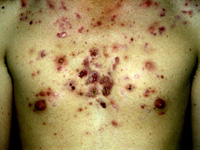Acne fulminans (also called acne maligna) is a severe form of acne that I occasionally encounter in my Woodlands dermatology and Conroe dermatology offices. It usually occurs suddenly in young males, in which they develop deep cystic scarring painful acneiform nodules on their trunk and face. Patients who develop acne fulminans usually have systemic symptoms such as fever and may develop polyarthritis causing them significant joint pain and difficulty moving. It is believed to be an immune system disorder in which the immune response to the acne bacteria Propionibacterium acnes triggers an abnormal inflammatory cascade of events. It also has a genetic component as patients may have a family history of acne fulminans. It is important to distinguish acne fulminans from acne conglobata, as acne fulminans does not respond to antibacterial therapy. Acne fulminans also displays distinct laboratory findings such as an elevated white blood cell count especially increased neutrophils, an elevated erythrocyte sedimentation rate, anemia, and proteinuria. SAPHO syndrome (synovitis, acne, pustulosis, hyperostosis, osteitis) is a variant of acne fulminans that most characteristically has lytic (destructive) bone lesions especially in the clavicle (collar bone). Treatment of acne fulminans requires systemic steroids.
September 29, 2010




